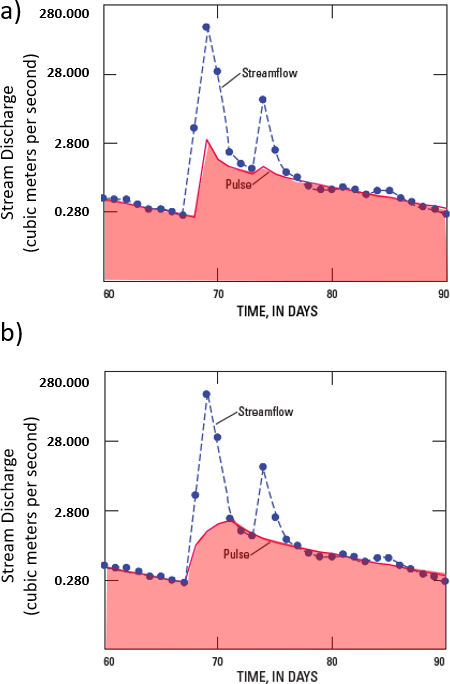5.2 Stream Hydrograph Separation Methods
Stream discharge records provide information on water yield of the basin above the location of the stream gauging site. Exchange between the stream and groundwater system can be inferred from analyses of both short- and long-term discharge records.
Stream discharge records are generated at a gauging site where stream stage is measured and a relationship between stage and discharge is available. Stream stage is reported relative to a reference datum, and is measured using a ruled staff, transducer, bridge-mounted measuring reel, acoustic sounder, electric water level gauge, and/or with equipment housed at official stream gauging stations (e.g., float, bubbler, transducer) as illustrated in Figure 54. In some settings, established stream gauging stations provide stage, discharge and geochemical data that are accessible in data bases and/or real time (e.g., USGS National Water Information System). When stream stage measurements are combined with discharge measurements at a wide range of flows, a stage-discharge relationship can be developed for the station (Figure 54c). A stage-discharge relationship, makes it possible to estimate stream discharge as a function of time when only stage is measured. These records can then be analyzed to determine net basin-scale exchange.

At the basin scale, groundwater exchange can be inferred using hydrograph separation techniques when effluent conditions dominate (e.g., Wisler and Brater, 1959; Meyboom, 1961; Rorabaugh, 1964; Rorabaugh and Simons, 1966; Hannula et al., 2003; Rutledge, 1993; Rutledge, 1998; Combalicer et al., 2008). Hydrograph separation involves interpreting the groundwater contribution to the measured stream discharge, base flow (Figure 23). Though hydrograph separation is sometimes viewed as deriving an estimate of total basin groundwater recharge (groundwater exchange), it actually represents the net discharge of groundwater to the stream over a given time period. In cases where basin groundwater flow bypasses the stream channel (e.g., underflow) or other water budget components are significant (e.g., evapotranspiration, pumping, and diversion of groundwater from the basin), base flow will not reflect total basin groundwater recharge (e.g., Rutledge, 2005; Combalicer et al., 2008). However, base flow separation proves useful when estimating annual, or event, groundwater exchange (effluent conditions) as shown in Figure 55.

Graphical, analytical, and forward and inverse numerical modeling tools have been developed to perform hydrograph separation. Standard hydrology and hydrogeology textbooks describe the methodologies (e.g., Fetter, 2001). As an example, Hannula and others (2003) used a hydrograph separation technique reported by Moore (1992) to estimate groundwater discharge to a creek in the Iron Mountain West Shasta Mining District in California, USA. They also computed average specific yield and average peak transmissivity of the unconsolidated materials adjacent to the creek.
A comparison of the results of six software packages developed to perform hydrograph separation is presented by Combalicer and others (2008). A variety of software including: PART (Rutledge, 2007a); RORA (Rutledge, 2007b); PULSE (Rutledge, 2002); Base Flow Index (BFI) (Wahl and Wahl, 2001); River Analysis Package (RAP) (Marsh et al., 2003); and, WHAT (Lim et al., 2004) are each applied to the same river hydrograph data set. Neff and others (2005) also assess multiple hydrograph separation methods in their analysis of base flow to the Great Lakes, USA and Canada.
